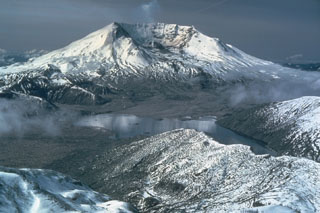Report on St. Helens (United States) — May 1998
Bulletin of the Global Volcanism Network, vol. 23, no. 5 (May 1998)
Managing Editor: Richard Wunderman.
St. Helens (United States) Sudden rise in earthquake activity in May
Please cite this report as:
Global Volcanism Program, 1998. Report on St. Helens (United States) (Wunderman, R., ed.). Bulletin of the Global Volcanism Network, 23:5. Smithsonian Institution. https://doi.org/10.5479/si.GVP.BGVN199805-321050
St. Helens
United States
46.2°N, 122.18°W; summit elev. 2549 m
All times are local (unless otherwise noted)
The level of earthquake activity at Mount St. Helens had been gradually increasing over the past several months and accelerated during May. Rates of activity increased from an average of ~60 well-located events per month last winter to 165 events in May. Most of the recent earthquakes were very small with only three events larger than M 2. The largest earthquake was on 1 May with M 2.2. These earthquakes occurred in two clusters directly beneath the lava dome in the crater. One cluster was in the range of 2-5 km and the other 7-9 km below the dome. Very few events were located in the very shallow region of 0-2 km below the dome. None of the earthquakes were low-frequency volcanic events that typically occur as precursors to major eruptions.
This increased activity seems to be similar to that which occurred in 1995, although the activity of May 1998 was more energetic. The 1995 activity lasted for several months, had a maximum earthquake rate of 95 events per month, and resulted in no volcanic activity. A similar increase in earthquake activity in the St. Helens system occurred in 1989-91. However, at that time there were also a number of very shallow earthquakes accompanied by a series of sudden steam explosions. These explosions were small eruptions of steam and gas that ejected rocks and ash from cracks in the dome. Rocks were thrown up to 1 km from the dome, ash clouds reached altitudes up to 6 km, and a dusting of ash was deposited locally downwind. Some explosions melted snow in the crater and generated small lahars that flowed N onto the Pumice Plain.
Because increased earthquake activity within the deep St. Helens system may reflect increased pressure at depth, it is possible that the current seismicity may eventually lead to renewed volcanic activity. However, it is unlikely to do so without significant additional precursors.
Geological Summary. Prior to 1980, Mount St. Helens was a conical volcano sometimes known as the Fujisan of America. During the 1980 eruption the upper 400 m of the summit was removed by slope failure, leaving a 2 x 3.5 km breached crater now partially filled by a lava dome. There have been nine major eruptive periods beginning about 40-50,000 years ago, and it has been the most active volcano in the Cascade Range during the Holocene. Prior to 2,200 years ago, tephra, lava domes, and pyroclastic flows were erupted, forming the older edifice, but few lava flows extended beyond the base of the volcano. The modern edifice consists of basaltic as well as andesitic and dacitic products from summit and flank vents. Eruptions in the 19th century originated from the Goat Rocks area on the N flank, and were witnessed by early settlers.
Information Contacts: Cascades Volcano Observatory, U.S. Geological Survey, 5400 MacArthur Blvd., Vancouver, WA 98661 USA (URL: http://volcanoes.usgs.gov/); Geophysics Program, University of Washington, Seattle, WA 98195 USA (URL: http://www.geophys.washington.edu/SEIS/PNSN/HELENS/).

